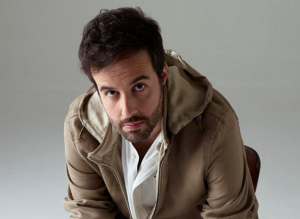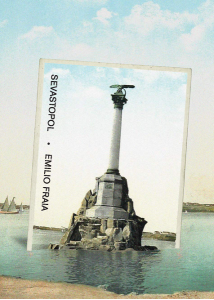by CELIA LEGBAND HAWLEY
Sevastopol, Emilio Fraia, New Directions Publishing, 2021.
Possibly the best advice I can give you about reading Emilio Fraia’s 2018 novel Sevastopol is: Do not let your first reading be your only one. The South American writer, editor, and journalist was named one of Brazil’s Best Young Writers in 2012 by British magazine, Granta. He has lived up to this reputation with Sevastopol. Available in Zoe Perry’s translation from the Portuguese as of 2021, this slim volume exudes power through something akin to writerly sleight of hand, with shifts in time and place that allow characters and circumstances to come into view and rotate out again, no apparent effort required. ‘Latent’ is the word I want to use – its punch sits beneath a conversational, deceptively light surface. Hints are dropped, foreshadowing is tucked-in, like breadcrumbs we don’t immediately recognize as such. The overall originality of the voice will make you sit up straighter in your chair. Compared in the publishing firmament to the likes of Tolstoy, Chekov, and Rachel Cusk, Fraia’s prose stands quite nicely on its own – but such an accomplished voice may always be said to echo its literary forebearers.
Structured as a collection of three sketches whose connection is more atmospheric than plot-based, the novel draws readers into decisive moments in the lives of the central characters. Longing, loss, and the drive to persist emerge as the real fabric of the book. The constant human struggle, whether with nature, society, or self, takes on a Sisyphean feel. As one of Fraia’s characters puts it, “And that with great hope also comes a great lack of hope.”
The book’s opening chapter is titled “December.” Its narrator, Lena, has been nursing a dream to summit the seven highest peaks in the world at a young age. Much of the section is written as the aftermath of her springtime Everest attempt, but in “December” time shifts as easily as the snowpack on that Himalayan peak. Throughout, Lena alludes to a climbing accident, one we will learn has cost her both her legs. It is from her wheelchair that Lena relates her story; and though the incident on the mountain might in other hands be the zenith of the action, it is in Fraia’s telling flattened to the relative plateau of various seemingly incidental episodes in Lena’s life: A beach visit with friends, a brief affair with a lover who was present on the mountain at that life-changing moment. Even the hubris associated with taking on the world’s highest peak is transmuted post-accident, as Lena’s management of her own story sees her turn her misfortune into a money-making vehicle which garners her a measure of celebrity. She is a character who cannot escape her own thoughts, constantly shuttling back and forth between the present and the moments on which she has mentally paused the tape of her life. One such rumination happens to hold the only allusion to Sevastopol in the novel’s first section. (Only in “August,” the final chapter, is the Crimean port city finally named and the well-known 19th– century battle for its control evoked.) The allusion reads:
Who would ever think that one day you wake up feeling fine, going after your dream of climbing a mountain, and at journey’s end a piece of your body simply no longer exists? When asked how he coped, one of the thousands maimed in the Crimean War said: The chief thing is not to think, it’s nothing much. It mostly all comes from thinking.
One source of Lena’s discomfort is her awareness that she has shaped her own story for profit, has again allowed her ambition to get the better of her. Gino, the videographer/lover who prompts and prods Lena in order to film her responses — the central conceit of the story — has exploited her experience by making it the stuff of his art. His is a video diary wherein he has taken editorial control of her history. Both versions of her story, her own and his, are exertions of a control that is ultimately illusory. Gino’s celluloid version is but that, an edited and elided record, as is her own memory of her narrative. No surprise, then, when Lena asks, “What really happened?” “What do we remember?” “What had I done with my story?” She notes,
But I do wonder: what’s the difference between the story in this video of yours and the one I’ve told myself for so long? Is there even a difference, in the end?
Lena’s story bumps up against both the banal — her word — and the heroic — mine — in equal manner; and her wistful, sad voice is unusually affecting. Perhaps that is always the case when one’s despair is of one’s own making.
The same can be said for the characters that follow in “May” and “August,” though these chapters are as different from each other as they are from Lena’s tale in “December.” In all three, however, Fraia’s use of telling detail and pithy, on-the-mark description contains worlds. Initially, for example, we know nothing about the place where “May” begins except that it is somewhere nearly empty of people and full of musty rooms. What follows is a near-perfect portrait of desuetude in two consonant sentences:
It’s a place with rusty cutlery at the bottom of heavy drawers. Chipped cups, chairs stacked atop the stained carpet in the corner of an empty hall.
In what turns out to be an all-but-abandoned hotel in the Brazilian countryside, two men, the proprietor Nilo and weary traveler Adan, an unlikely pair, will exchange life stories and memories in Fraia’s signature style. Here is Adan recounting to Nilo his years working at a job in the state department of roadways as a young man in Peru:
At the time, I thought things might get better, that the job might lead somewhere, as if a job could lead anyone anywhere, but back then I was betting it would, and so without even realizing it, over time I slowly became part of that room, with those lucuma-colored walls and metal filing cabinets, waiting for the swivel of a fan that didn’t really do much, that is to say, nothing at all, against Lima’s radioactive heat.
In this chapter, more than in either of the other two, the topography of the surrounding land plays a prominent role. The inn is “drowning in the landscape, about to get swallowed up by the surrounding wilderness.”

The pages of “May” are so dotted with references to eucalyptus trees, especially those on top of the mountains, that I found myself doing a bit of research on the talismanic tree. As I learned, this species that I associate with Australia is grown and valued in South America for its use in the charcoal, pulp, and paper industries. A member of the myrtle family, which is prized for its essential oils, it is highly flammable due to that oil, and ignited trees have been known to explode. This propensity to burn is familiar to Adan, who believes fire has always followed him. And in what could be a nod to the fateful incident previously recounted in “December,” Adan thinks of a market that caught fire in 1983 and concludes: “This might have seemed symbolic but deep down, of course, life’s accidents can’t explain anything, old pal, absolutely nothing.” Perhaps the potential explosive force of the fiery eucalyptus, like that of a market or forest fire, is at once as purifying and generative of new life as it is destructive.
The role of stories themselves is again central to this section and is regularly returned to. In Adan’s telling:
In the end, old pal, that’s all there is to it: people have just two or three stories in their lives. You won’t learn anything from it. No one learns anything from any story.
And in Nilo’s:
Nilo thinks that men’s stories are all one and the same. So when our past is hollowed out, when we free ourselves from it, we can go on to live other lives, find our story in other lives, as if there were a continuum of bodies and minds, and Adan’s story is also his story, and also his life.
By the time we turn the page to find the waiting “August,” it has become clear that the relationships that grow on Fraia’s pages tend to peter out; matches are more likely to be mismatches, and loneliness is often combatted by the hankering for connection, rather than by fruitful connection itself. But what do you do when your expectations of people are thwarted, unmet? Walk away, or continue walking? Expectations can prevent you from seeing what is really there, who is really there. To continue walking, as Fraia’s characters do, is to be open to the reality that finding some satisfaction in seemingly incongruous relationships is preferable to finding none.
The final vignette of the triptych is the only one with a direct reference to the title city of Sevastopol. Interestingly, an image of the seaport — clearly not the same iconic symbol that graces the cover of my copy of the book — arrives in Sao Paulo in the form of a picture postcard, and describes the famous battle site as “a soulless port framed by gray buildings, a generic scene, the kind with no story to tell.” Once again, the story is the thing.
In this section we are witness to two characters as they work together in Sao Paulo to create and put on an historical play set in 1855 Russia during the Siege of Sevastopol and featuring the fictional painter Bogdan Trunov. Klaus and Nadia have met at a museum. He is a drama teacher in his 60’s and she is a young woman who quits her museum job to be his researcher and cowriter. As happens with some frequency in this novel, an observation particular to an individual or segment also does the work of delivering a wider thematic message. About an actor Klaus thinks would be perfect to play the role of Trunov, “the desired strange and distant quality” he would bring to the role is that “of being and not being at the same time.” Those words ring equally true for the personae in all three sections in the novel. A character invented by a character, Trunov the painter does not capture the war raging in Sevastopol with his brush, but rather works in a syncopation emblematic of Fraia’s own stylistic choice: he displaces the expected accent with the unaccented, giving the quotidian the stronger beat:
He didn’t capture the upheaval, the triumphant generals, the human suffering. Instead he focused on the soldiers’ everyday lives, when they weren’t at the front: the little breaks, the downtime when nothing was happening, soldiers with grubby faces waiting to hear the whereabouts of their artillery batteries or playing cards at a staging post.
Emphasis is created by avoiding the obvious, by downplaying the dramatic, and by calling out the mundane and the everyday with apt and telling description. The asymmetrical balance Fraia thus achieves is a cornerstone of the storytelling in this slight but mighty novel. So how does Sevastopol earn the title position of this work? In just this way. It is a “city with a funny name” situated on a Black Sea that “looks like a big hole. Or rather, a drain in the middle of the map, where the whole world will get flushed away.” It is that thing we seek within these pages whose presence lies most conspicuously in its absence.
Finally, “August,” like it’s companion chapters, is not without its own say on the nature of story. Nadia narrates below:
Klaus wiped milk from his mustache with a napkin and said that all stories, at heart, were weird stories where nothing happened. We are the past, he said. I said, no, we’re the future. He laughed at that. I asked him to explain what was funny. He said no, he wasn’t going to explain anything to me. … I ate my toast, looked at Klaus, and thought that, if anything was weird, it was my life.
Collectively, then, the Fraia sketches link a cast of lost souls in a set of stories within stories. Each reads like a slowly deepening mystery, spare and despairing, charming in detail and ingenuity. Ambition, striving, defeat … or is that victory? Resignation. Repeat.
People always tell the same stories, even when they try to tell new stories. Stories are laid out in front of us, like objects, and over time we realize that they’re all made of the same material, a solid mass of stone and metal.
And if the solid mass of these stories, their construction and durability, means that the young Brazilian’s award-winning voice is here to stay, that is cause for celebration.


